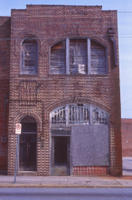Raleigh in 6 Small Prints
Photography by Andy Osterlund
Downtown Raleigh continues to grow and change. If architecture can be read, Raleigh’s streetscapes are building a novel. Walking the sidewalks, a visitor finds chapters on warehouses and industry, moderately ornate turn-of-the-last-century storefronts, towers of a growing banking center, neighborhoods of eccentric affluence and communities of generations-old poverty. Dramatic chapters are being written now, and the suspense is building: a multi-modal transit hub, neighborhood redevelopment, a returning urban population.
These photos are portraits of our moment in architecture. Remember the colors, remember the shadows, the perpetual changing of places.
1. Fashion Center of New York, Inc. Wilmington Street
No.2 in a series of 4 storefronts. The second floor windows are blacked; daylight is visible at the first floor – the rear wall and roof are absent.
2. Reliable Loan Wilmington Street
Closed on Sundays, the best place in town to get a used diamond ring. Who can miss this color?
3. Smoked Turkey Grill South Street
A new business on a desperate block. Blocks around the corner from the Mayor’s house. Pegged a “gateway corridor;” pending wholesale community rehabilitation.
4. Dillon Supply Steel and Pipe Products Harrington Street
The solid brick warehouse edge of the downtown. Now being emptied to make way for a colossal transit hub. Three silver SUV's.
5. Audio Buys Glenwood Avenue, near Fairview
An experiment in the International Style, just like Mies. Set across a wasteland of an intersection, flanked by BP and trimmed with power lines.
6. Firestone at Dusk Dawson Street
The sun catches this tire shop and the city on the crest of a hill, on a one-way street out of town.
All 5x7 Cibachrome prints, non-digital; all available for purchase.





